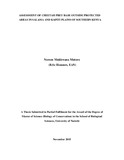| dc.contributor.author | Mutoro, Noreen, M | |
| dc.date.accessioned | 2016-11-28T09:15:56Z | |
| dc.date.available | 2016-11-28T09:15:56Z | |
| dc.date.issued | 2016 | |
| dc.identifier.uri | http://hdl.handle.net/11295/97909 | |
| dc.description.abstract | Over 80% of Kenya’s cheetah (Acinonyx jubatus) population range falls in community and
private lands. Conversion of cheetahs’ historical and geographical ranges into farmlands has
led to loss of habitat quality and natural resources necessary for their survival. Understanding
food resources and habitat characteristics that maintain cheetah populations outside protected
areas is critical for cheetah conservation. This study therefore sought to assess density and
distribution of potential cheetah prey in various habitat types in Kapiti and Salama areas of
southern Kenya and the significance of each prey species in the cheetah diet. It also
investigated vegetation characteristics of available cheetah habitats in the study area. Data on
potential prey distribution and abundance were collected from July 2013 to February 2014 by
means of transect counts. Cheetah scats were collected opportunistically in the study area for
prey species determination using hair characteristics and their frequency of occurrence
computed. Plot and plotless sampling methods were used to determine vegetation
characteristics in sites frequently used/visited by the cheetah. A total of 19 wild mammalian
prey species were recorded in woodland, bushed grasslands and open grassland habitats.
Habitat type did not significantly influence cheetah prey species abundance in the three
habitat types apart from the warthog (χ
2 0.05, 2= 0.8). Hairs from 21 mammalian species were
identified from 27 confirmed cheetah scats. Cheetah diet in the study area was dominated by
Grant’s gazelle (25.9%), Cape hare (22.2%) and goat (18.5%). Cheetah showed preference
for wild ungulate prey (40.7%) compared to domestic animals (11.1%). Cheetah frequently
used woodlands, shrub lands and bushed grasslands but did not show preference for any of
the three habitat types. Strategies that encourage habitat and species conservation in
farmlands should be developed to promote survival of the cheetah and other carnivore
species. Monitoring of cheetah prey and their influence on cheetah movement patterns
outside protected areas should be continued with a view to enhance cheetah conservation by
minimizing conflict between cheetahs and people.
Key Words: Acinonyx jubatus, habitat assessment, scats, prey, faecal hair analysis. | en_US |
| dc.language.iso | en | en_US |
| dc.publisher | University of Nairobi | en_US |
| dc.rights | Attribution-NonCommercial-NoDerivs 3.0 United States | * |
| dc.rights.uri | http://creativecommons.org/licenses/by-nc-nd/3.0/us/ | * |
| dc.subject | Assessment of Cheetah Prey Base Outside Protected Areas in Salama and Kapiti Plains | en_US |
| dc.title | Assessment of Cheetah Prey Base Outside Protected Areas in Salama and Kapiti Plains of Southern Kenya | en_US |
| dc.type | Thesis | en_US |



